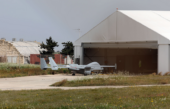According to the new regulation, a total of 1,500 forces are to be located directly at Frontex. This is the first time that the European Union is commanding a police corps with a common uniform. However, there is no legal basis for the planned acquisition of weapons, ammunition and “non-lethal equipment”.
By 2027 the EU Border Agency wants to establish a “Standing Corps” of 10,000 border police officers. The personnel, almost two-thirds of which are to be recruited by next year, is divided into four categories. 3,000 additional “Category 1” officers are to be directly subordinated to the agency’s headquarters in Warsaw. At present there are about 1,500 employees working there, most of them are not uniformed. In order to be able to grow up, Frontex is moving its headquarters in 2024 to a new building, also erected in the Polish capital.
With 1,500 officers, the “long-term” deployment forces in “Category 2” represent a comparatively small part of the “permanent reserve”. These are personnel from the Member States who are seconded to Frontex for at least 24 months. The German Federal Police will initially deploy 61 police officers, later it is planned to increase to 225. Frontex wants to mobilize 5,500 officers from the Member States for short-term deployments in “Category 3”, and another 1,500 in the “Reserve for Immediate Action” in “Category 4”. Here the agency will draw on the existing “Rapid Border Intervention Teams”, which have so far only been deployed in Greece.
Creating “authority”
Up to now, the deployed units on missions of the border agency have been wearing uniforms from their sending countries, with a unique armband identifying them as part of Frontex. The new Frontex regulation adopted last year stipulates that EU “Category 1” officers should wear their own uniforms as a EU police unit.
Frontex therefore published a corresponding call for tender in August. As in most member states, the EU border troops are also to wear blue uniforms. With their design, they are supposed to create authority and “not intimidating”. In this way Frontex wants to “symbolically convey the values of the European Union”.
No legal basis for own firearms
Forces deployed from Member States shall be armed with the usual means of intervention from their sending countries, including service pistols, batons, pepper spray, tear gas or handcuffs. But Category 1″ personnel shall be equipped with own weapons, ammunition and other means of coercion. However, this raises legal problems, because Frontex apparently did not consider that the new regulation does not provide a legal basis for its own firearms.
Polish laws do not mention the Border Agency as a unit that is allowed to purchase firearms or ammunition. They cannot be acquired, registered, stored or transported to operational areas. The headquarters agreement that Frontex has concluded with the government in Warsaw does not allow this either. This is the conclusion of two expert opinions that Frontex has requested from an “external expert” and a law firm for regulatory issues.
Talks with weapons manufacturers
Nevertheless, Frontex prepared all requirements for the acquisition of its own weapons, ammunition and “non-lethal equipment” as early as April. An invitation to tender should be issued as soon as the EU Commission has “clarified” the legal situation. According to Frontex, Poland, for example, could issue a special permit. However, it is the responsibility of the European Commission to negotiate such a permit, which must be commissioned by the Council.
However, according to a Frontex communication of September 1, a solution is not in sight. Frontex has already held talks with arms manufacturers who have promised quick delivery. However, deadlines have to be met in the procurement process, so that the acquisition will probably not be possible by the end of the year. As a result, the question of armament could mean that the “Standing Corps” will not be ready for deployment at the beginning of 2021 as planned.
Image: Frontex uniforms (EU Council).





Leave a Reply